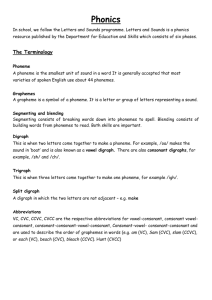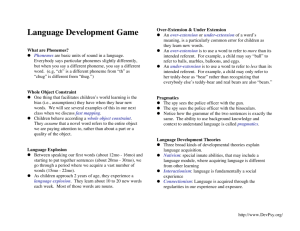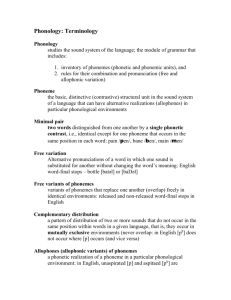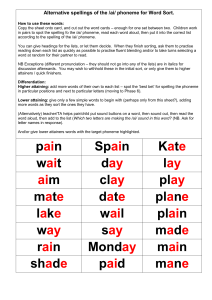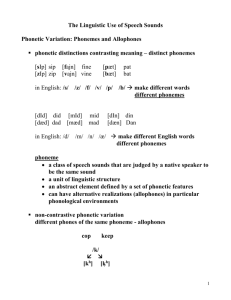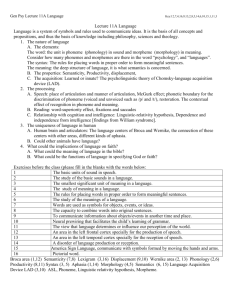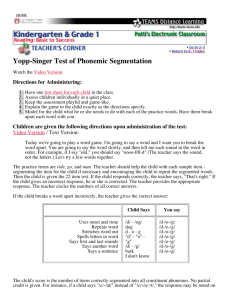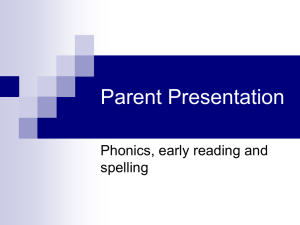Parsing Noisy Sentences
advertisement
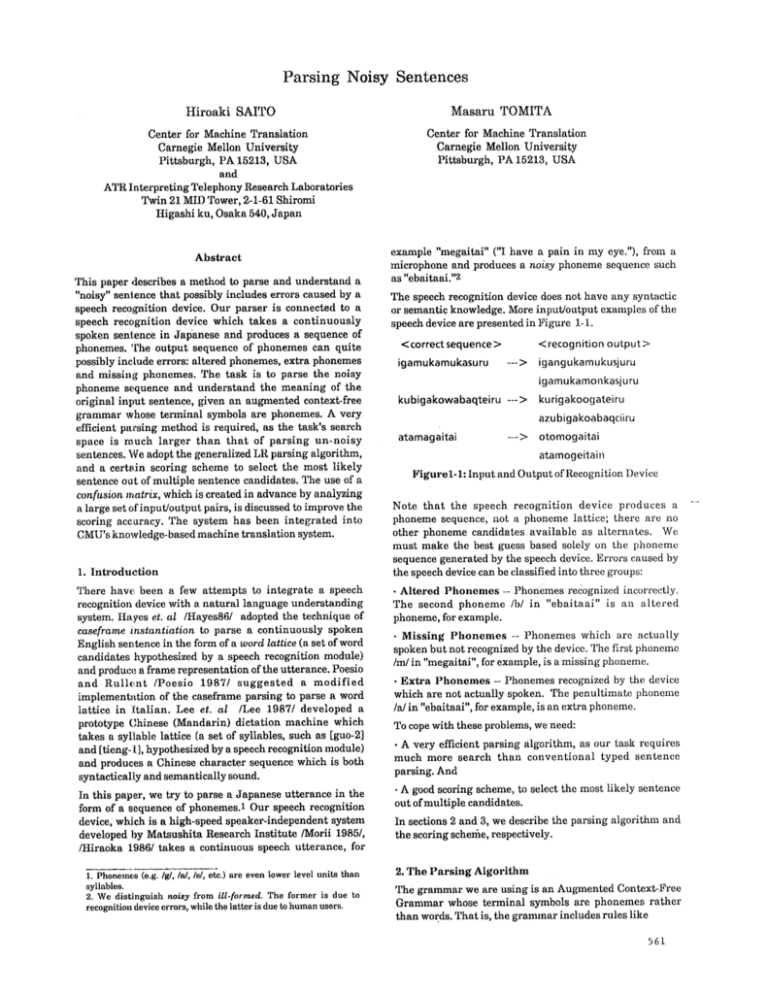
Parsing Noisy Sentences
Hiroaki SAITO
Center for Machine Translation
Carnegie Mellon University
Pittsburgh, PA 15213, USA
and
ATR Interpreting Telephony Research Laboratories
Twin 21 MID Tower, 2-1-61 Shiromi
Higashi ku, Osaka 540, Japan
Abstract
This paper describes a method to parse and understand a
"noisy" sentence that possibly includes errors caused by a
speech recognition device. Our parser is connected to a
speech recognition device which t a k e s a c o n t i n u o u s l y
spoken sentence in Japanese and produces a sequence of
phonemes. The output sequence of phonemes can quite
possibly include errors: altered phonemes, extra phonemes
and missing phonemes. T h e task is to parse the noisy
phoneme sequence and understand the m e a n i n g of the
original input sentence, given an augmented context-free
grammar whose terminal symbols are phonemes. A very
efficient parsing method is required, as the task's search
space is much l a r g e r t h a n t h a t of p a r s i n g u n - n o i s y
sentences. We adopt the generalized LR parsing algorithm,
and a certain scoring scheme to select the most likely
sentence o~t of multiple sentence candidates. The use of a
confusion matrix, which is created in advance by analyzing
a large set of input/output pairs, is discussed to improve the
scoring accuracy. The system has been integrated into
CMU's knowledge-based machine translation system.
1. I n t r o d u c t i o n
There have~ been a few attempts to integrate a speech
recognition device with a natural language understanding
system. Ita~,es et. al /Hayes86/ adopted the technique of
caseframe instantiation to parse a continuously spoken
English sentence in the form of a word lattice (a set of word
candidates hypothesized by a speech recognition module)
and produce a frame representation of the utterance. Poesio
a n d R u l l e m t / P o e s i o 1987/ s u g g e s t e d a m o d i f i e d
implementation of the caseframe parsing to parse a word
lattice in :italian. Lee et. al /Lee 1987/ developed a
prototype Chinese (Mandarin) dictation machine which
takes a syllable lattice (a set of syllables, such as [guo-2]
and [tieng-:l], hypothesized by a speech recognition module)
and produces a Chinese character sequence which is both
syntactically and semantically sound.
In this paper, we try to parse a Japanese utterance in the
form of a sequence of phonemes.1 Our speech recognition
device, which is a high-speed speaker-independent system
developed by Matsushita Research Institute/Morii 1985/,
/Hiraoka 1986/ takes a continuous speech utterance, for
1. Phonemes (e.g./g],/ed, Is/, etc.) are even lower level units than
syllables.
2. We distinguish noisy from ill-formed. The former is due to
recognition device errors, while the latter is due to human users.
Masaru TOMITA
Center for Machine Translation
Carnegie Mellon University
Pittsburgh, PA 15213, USA
example "megaitai" ("I have a pain in my eye."), from a
microphone and produces a noisy phoneme sequence such
as "ebaitaai."2
The speech recognition device does not have any syntactic
or semantic knowledge. More input/output examples of the
speech device are presented in Figure 1-1.
< correct sequence >
igarnukamukasuru
<recognition output>
--->
igangukamukusjuru
igamukamonkasjuru
kubigakowabaqteiru --->
kurigakoogateiru
azubigakoabaqciiru
atamagaitai
---:> otomogaitai
atamogeitain
F i g u r e l - 1 : Input and Output of Recognition Device
Note t h a t the speech recognition device produces a
phoneme sequence, not a phoneme lattice; there are no
other phoneme candidates available as alternates. We
must make the best guess based solely on the phoneme
sequence generated by the speech device. Errors caused by
the speech device can be classified into three groups:
• A l t e r e d P h o n e m e s -- Phonemes recognized incorrectly.
The second phoneme /b/ in " e b a i t a a i " is an a l t e r e d
phoneme, for example.
• M i s s i n g P h o n e m e s -- Phonemes which are actually
spoken but not recognized by the device. The first phoneme
/nd in "megaitai", for example, is a missing phoneme.
• E x t r a P h o n e m e s -- Phonemes recognized by the device
which are not actually spoken. The penultimate phoneme
/a/in "ebaitaai", for example, is an extra phoneme.
To cope with these problems, we need:
• A very efficient parsing algorithm, as our task requires
much more search t h a n conventional typed sentence
parsing. And
• A good scoring scheme, to select the most likely sentence
out of multiple candidates.
In sections 2 and 3, we describe the parsing algorithm and
the scoring schelhe, respectively.
2. T h e P a r s i n g A l g o r i t h m
The grammar we are using is an Augmented Context-Free
Grammar whose terminal symbols are phonemes r a t h e r
than words. That is, the grammar includes rules like
561
Noun-->watasi
instead of
N o u n -- > 'watasi'
The grammar has •been developed p r i m a r i l y for CMU's
knowledge-based machine t r a n s l a t i o n system /Tomita
1987/and consists of more than 2000 rules including lexical
rules like One above.3
2.1. G e n e r a l i z e d L R P a r s i n g
Tomita /Tomita 1985/, /Tomita 1987b/ introduced the
Generalized L R P a r s i n g A l g o r i t h m for A u g m e n t e d
Context-Free Grammars, which• can ingeniously handle
nondeterminism and ambiguity with a graph-structured
• stack. Tomita also showed that it can be used for a word
lattice parsing fromita 1986/. Our algorithm here is based
on Tomita's parsing algorithm.
A very simple example grammar is shown in Figure 2-1,
and its LR parsing table, compiled automatically from the
grammar, is shown in Figure 2-2.
(1)
(2)
(3)
(4)
(5)
(6)
(7)
(8)
S -->
S -->
S -->
NP-->
N -->
N-->
P -->
PD - - >
NP PD
N
PD
N P
m e
i
g a
i t a i
F i g u r e 2-1: An Example Grammar
State a
e
m
g
t
$
N NP P PD S
. . . . . . . . . . . . . . . . . . . . . . . . . . . . . . . . . . . . . . . . . . . . . . . . . . . . . . . . . . . . . . . . . . . . . . . . . . . . .
0
1
2
3
4
5
6
7
8
9
10
11
12
13
14
15
s4
s5
2
3
1 6
r3
8
s7,r2
s9
10
r6
s11,r6
s12
acc
s13
r4
sll
rl
s14
r5
r5
r7
s15
r8
action "shift one word f r o m i n p u t buffer onto the stack and
go to state n". Entries "r n" indicate the action "reduce
constituents on the stack using rule n". The entry "acc"
stands for the action "accept", and blank spaces represent
"error". The goto table (the right part of the table) decides
to which state the parser should go after a reduce action.
While the encountered entry has only one action, parsing
proceeds exactly the same way as LR parsers, which are
often used in compilers of programming languages. When
there are multiple actions in one entry called conflicts, all
the actions are executed in p a r a l l e l with the graphstructured stack. We do not describe the Generalized LR
parsing algorithm in greater detail, referring the reader to
/Tomita 1985/,/Tomita 1986/, fromita 1987b/.
2.2. H a n d l i n g a l t e r e d , e x t r a , a n d m i s s i n g p h o n e m e s
To cope with altered, extra and missing phonemes, the
parser must consider these errors as it parses an input from
left to right. While the algorithm described in the previous
subsectio n cannot handle these noisy phenomena, it is well
suited to consider many possibilities at the same time, and
therefore, it can be relatively easily modified to handle
such noisy phenomena as the following.
• A l t e r e d p h o n e m e s -- Each phoneme in a phoneme
sequence may have been altered and thus may be incorrect.
The parser has to consider all these possibilities. We can
create a phoneme lattice dynamically by placing alternate
phoneme candidates in the same location a s the original
phoneme. Each possibility is then explored by each branch
of the parser, Not all phonemes can be altered to any other
phoneme~ For example, w h i l e / o / c a n be mis-recognized as
/ u / , / i / c a n never be mis-recognized a s / o / . This kind of
information can be obtained from a confusion m a t r i x ,
which we shall discuss in the n e x t section. W i t h the
confusion matrix, the parser does not have to exhaustively
create alternate phoneme candidates.
-- Each p h o n e m e in a p h o n e m e
sequence may be an extra, and the parser has to consider
these possibilities. We have one branch of the p a r s e r
consider an extra p h o n e m e by s i m p l y i g n o r i n g the
phoneme. The parser assumes at most one extra phoneme
can exist between two real phonemes, and we have found
the assumption quite reasonable and safe.
• Extra phonemes
• M i s s i n g p h o n e m e s -- Missing phonemes can be handled
by inserting possible missing phonemes between two real
phonemes. The parser assumes that at most one phoneme
can be missing between two real phonemes.
F i g u r e 2-2: LR Parsing Table with Multiple Entries
2.3. A n E x a m p l e
G r a m m a r symbols of lower case characters are terminals.
The Generalized L R parsing algorithm is a table driven
shift-reduce parsing algorithm that can handle arbitrary
context-free grammars in polynomial time. Entries "s n" in
the action table (the left part of the table) indicate the
3. The run-time grammar, which contains both syntax and
semantics, is compiled automatically from more abstract
formalisms: the Functional Grammar formalism for syntax and
frame representation for semantics. For more discussions on this
UniversaIParserArchitecture, see fromita 1987a].
562
In this subsection, we present a sample trace of the parser.
Here we use the grammar in Figure 2-1 and the LR table in
Figure 2-2 to try to parse the phoneme sequence "ebaitaai"
r e p r e s e n t e d in F i g u r e 2-3. (The r i g h t s e q u e n c e is
"megaitai" which means "I have a pain in my eye.")
T.i r
I,l ,, :
J,
Figure 2-3: An input sequence ofphonemes
that "m e" is a successful parse. But only the first phoneme
"e" of the input sequence "ebaitaai" is consumed at this
point. Thus we discard t h i s p a r s e by the following
constraint•
In this example we make the following asumptions for
altered and Zaissing phonemes.
•/i/may possibly be mis-recognized as/e/.
•/e/may posvibly be mis-recognized as/a/.
[ C o n s t r a i n t 1] The successful parse should consume the
phonemes at least until the phoneme just before the end of
the input sequence.
. / g / m a y possibly be mis-recognized as/b/.
• / m / m a y be missed in the output sequence with a higher
probability.
Note that only the parse S in Figure 2-8 is ignored and that
the nonterminal N in Figure 2-7 is alive.
Now we begin parsing: first an initial state 0 is created.
The action table indicates that the initial state is expecting
"m" and 'T' (Figure 2-4). Since the parsing proceeds strictly
from left to right, the parser looks for the missing phoneme
candidates between the first time frame 1 - 2. (We will use
the term T1, T2 .... for representing the time 1, time 2 .... in
Figure 2-3.) Only the missing phoneme "m" in this group is
a p p l i c a b l e to s t a t e 0. The new s t a t e n u m b e r 5 is
determined from the action table(Figure 2-5).
Now we return to the Figure 2-6 and continue the shift
action of 'T'. After "i" is t a k e n , the new s t a t e 4 is
determined from the action table. This state has a multiple
entry, i.e. state 4 is expecting "t" and ready for the reduce
action. Thus we reduce "i" into N by rule 6. Here we use the
local a m b i g u i t y p a c k i n g technique, because the reduced
nonterminal is the same, the starting state is 0 for both,
and the new state is 2 for both. Thus we do not create the
new nonterminal N.
The next group of phonemes between T2 and T3 consists of
the %" phoneme in the phoneme sequence and the altered
candidate phonemes of "e". I n this group %" is expected by
state 5 and 'T' is expected by state 0(Figure 2-6). After "e"
is taken, the new state is 12, which is ready for the action
"reduce 5". Thus, using the rule 5(N -- > m e), we reduce
the phonemes "m e" into N. F r o m s t a t e 0 w i t h the
nonterminal N, state 2 is determined from the goto table.
The action table, then, indicates that state 2 has a multiple
entry, i.e., state 2 is expecting "g" and ready for the reduce
action(Figure 2-7). Thus, we reduce the nonterminal N into
S by rule 2(S - - > N), and the new state number 6 is
determined fl'om the goto table(Figure 2-8). The action
table indicates that state 6 is an accept state, which means
1
0
i
*i
*i
*m,
2
2
[
5
Now we go on to the next group of phonemes between T3
and T4. Only "m" is applied to the initial state(Figure 2-9).
The next group of phonemes between T4 and T5 has one
applicable phoneme, i.e. an altered phoneme candidate "g"
to state 2. After "g" is taken, the new state 7 is determined
from the action table (Figure 2-10).
The next group of phonemes between T5 and T6 has only
one applicable phoneme; a missing phoneme candidate "m"
to stateO. Here we can introduce another constraint which
discards this partial-parse.
[ C o n s t r a i n t 2] After consuming two phonemes of the input
sequence, no phonemes can be applied to the initial state 0.
3
*i
*m 1 ~ 3 *e
*e
0 ;;'"", ..m..
[rS]
4
1
3
i
'e
*i
*m
Figure 2-4
2
1
*m
'12
o "::::::
".):'~
*e
m
m
m
e
::::::..
*t
Figure 2-6
5
'2
Jr2]
*e
i *g
i
5
*e
m
2
*g
$
12
~ 4
'i.... *t~
, i 4[r61
2
:~."
*m
o
'4
5
*i
12
2
*g i
6
aec
Figure 2-7
Figure 2-5
1
2
I
3
*i
5
*m
"e
"::'"".::.
2
*i
*ozm..... ~
12
o "::;:::"7""7"
-
0 "(':::: m
',.
4
:;::::::
m
2
*g
6
3
5
i
4
*t
*a
*e1 2
:::::.
4
"7....
*a
I
N '*t
!
"~
4,
5
*m
i
*e '7
g
3
2,
*i
1
12
*e
"7"
%,
5
... ,
Figure 2-9
Figure 2-8
,,..,~5
m I *e
[rT]
Sg'.
m
13
N
i
[r4]
NP
Figure 2-10
Figure 2-11
[
13i
Figure 2-12
563
1
4
2'53
"Y
3
(
*i
5
*e
*m
*e
e
0 ""::'
e
*i
*m
0 ""::".:.
~. ,,: m
"..~':::i
51
*e
4
5
1
12. 13 14 15. 16 17
1'
12
4
m
12
m
*g
"i
g "Y""
N
*R
,
i
t'i
14
13
/
*i
M
13
"2"
.'
P
.
t,
"!
I
5
Figure 2-13
Figure2-14
This constraint is natural because it is unlikely t h a t more
t h a n two p h o n e m e s a r e r e c o r d e d before t h e a c t u a l
beginning phoneme for our speech recognition device.
The next group of phonemes between T6 and T7 has two
applicable phonemes, i.e. the output phoneme "a" to state 7
and the altered phoneme candidate "e" to state 5. After "a"
is taken, the new state 7 is ready for the reduce action.
Thus, we reduce "g a" into P by rule 7 (Figure 2-11). The
new state 8 is determined by the goto table, and is also
ready for the reduce action. Thus we reduce "N P" into N P
by rule 4 (Figure 2-12). The new state is 3. In applying "e",
there are two "state 2"s: one is "m" between T1 and T2; the
other one is "m" between T3 and T4.'Here we can introduce
a third constraint which discards the former partial-parse.
[ C o n s t r a i n t 3] A shift action is not applied when ,the
distance between the phoneme and the applied
(non)terminal is more than 4. (This distance contains at
least one real phoneme.)
Figure 2-13 shows the situation after "e" is applied.
The parsing continues in this way, and the final situation
is shown in Figure 2-14. As a result, the parser finds two
successful parses; "megaitai" and "igaitai"(which means "I
have a stomachache.")
3. S c o r i n g a n d the C o n f u s i o n M a t r i x
There are two main reasons why we want to score each
parse: first, to prune the search space by d i s c a r d i n g
branches of the parse whose score is hopelessly low; second,
to select the best sentence out of multiple candidates by
comparing their scores. B r a n c h e s of the parse which
consider fewer altered/extra/missing phonemes should be
given higher scores• W h e n e v e r a b r a n c h of the parse
handles an a l t e r e d / e x t r a / m i s s i n g phoneme, a specific
penalty is given to the branch. Scoring accuracy can
improve with the confusion matrix.
Figure 3-1 shows a part of the confusion matrix made by
the manufacturer of the recognition device from the large
word data. This matrix tells us, for example, that if the
phoneme /a/ is inputed, then the device recognizes i t
564
I\O
lal
la/
93.8
Iol
lul
/i/
~el
Io/
lil
11
I
I "~c
(I) (ll)
~el
Ijl
lwl
...
1.1
1.3
0
2.7
0
0
...
0.9
2.4 84.3
5.8
0
0.3
0
0.6
...
6.5
7529
1.8 79.7
2.4
4,6
0.1
0
...
9.7
5722
91.2
0.3
lul
~
15
[r81
*i
..
5477
0.2
0
0.9
3~5
0.7
0
...
2.9
6158
1.9
0
4.5
3.3 89.1
0.1
0
....
1.1
3248
Iwl
0
0;2
0
5.1
1.1
5.8
2.3
0.5
2.2
0
(m)
327
176
564
512
290
/j/
80.1 0.3
...
2.6 56.1 . . . .
864
11.4 2660
11.2 428
212
rate of missing phonemes
total number of samples
(ii') number of extra phonemes
Figure 3. I:A Confusion Matrix (portion)
correctly 93,8% of the time; mls-recognizes it as/o/1.1% of
the time, as/u/1.3% of the time, and so on. The column (I)
says that the input is missed 0.9% of the time.
Conversely, if the phoneme/o/is generated from the device,
there is a slight chance that the original input w a s / a / , / u /
and/w/, respectively, but no chance that the original input
was/i/,/e/or/j/. The probability of the original input being
/a/ is much higher than being /w/. Thus, an a l t e r e d
p h o n e m e / w / s h o u l d be given a more severe penalty than
/a/. A score for altered phonemes can be obtained in this
way, missing phonemes should be E v e n a negative score,
and extra phonemes should be given a zero or a negative
score. With this scoring a score of a partial parse is
calculated by summing up the score of each constituent.
Therefore, themore likelyparse has a higher score.
T w o methods have been adopted to prune partial parses by
a score:
• Discarding the low-score shift-waiting branches when a
phoneme is applied.
• Discarding the low-score branches in a local ambiguity
packing.
The former method isvery effectivewhen strictlyapplied.
The confasion matrix only shows us the phoneme-tophoneme f;ransition, therefore a broader unit transition
should also be considered, such as a tendency for the/w/:
phoneme ia 'owa' or 'owo' to be missed or for the very first
/h/ sound of an input to be missed, and the frequent
transformation to 'h@' of the 'su' sound in 'desuka.'
References
/Hayes 1986/ Hayes, P. J., Hauptmann, A. G., Carbonell,
J. G., and Tomita, M.
Parsing Spoken Language: A Semantic Caseframe
Approach. l l t h International Conference on
Computational Linguistics (COLING86). Bonn, August,
1986.
4. Conclu,,dons
The parser has been implemented in Common Lisp on a
Symbolics Lisp Machine and is being integrated into
CMU's knowledge-based machine translation system to
accept a spoken Japanese sentence in the domain of doctorpatient conversation and generate sentences in English,
German and Japanese.
/Hiraoka 1986/ Hiraoka, S., Morii, S., Hoshimi, M., and
Niyada, K.
Compact Isolated Word Recognition System for Large
Vocabulary. IEEE-IECEJ-ASJ International Conference
on Acoustics, Speech, and Signal Processing (ICASSP86).
Tokyo, April, 1986.
The parser has been tested against five persons. Each
person pronounced 27 sentences in which long sentences
are not included due to the limits of the speech recognition
device. 84 % of the inputs are parsed correctly and the right
sentence appears as the best-score candidate in 88 % out of
the correct~ly parsed inputs. The average parsing time for
one sentence is 82 seconds.
/Lee 1987/ Lin-shan Lee, Chiu-yu Tseng, K.J. Chen, and
James Huang.
The Preliminary Results of A Mandarin Dictation Machine
Based Upon Chinese Natural Language Analysis.
Proceedings of the Tenth International Joint Conference on
Artificial Intelligence. Milan, August, 1987.
Acknowledgements
The authors would like to thank Shuji Morii for giving us
the opportunity to use the speech recognition device and to
thank other members of the Center for Machine
Translatioa for useful comments and advices. We are also
indebted to ATR Interpreting Telephony Research
Laboratories for providing the computational environment.
Appendix. Sample Runs
Two actual outputs of the parser are shown on the next
page. The first input phoneme sequence is "ebaitaai" and
the correct sequence is "megaitai"(which is the same
sentence as in the example in Section 2.), which is
produced as the top-score sentence of all parses. The second
input sequence is "kurigakoogateiru =" and the correct
sequence is "kubigakowabaqteiru" which means "I have a
stiff neck." The frame-structure output after each parse is
the meaning of the sentence. This meaning is extracted in
the same way the CMU's machine translation system does.
Namely, ~;ach rule of the context free grammar has a
function which is executed each time the rule is applied (i.e.
when the reduce action occurs.) If tale function returns nil,
this partial parse is discarded because the parse is not
correct semantically. If the function returns a non-nil
value, the value becomes the semantic of the right-handside of the rule and is forwarded to the left-hand-side
nonterminal symbol. The details are described in fromita
19870/.
/lVlorii 1985/ Morii, S., Niyada, K., Fujii, S., and Hoshimi,
M.
Large Vocabulary Speaker-independent Japanese Speech
Recognition System. IEEE International Conference on
Acoustics, Speech, and Signal Processing (ICASSP85).
TamPa, March, 1985.
/Poesio 1987/ Poesio, M. and Rullent, C.
Modified Caseframe Parsing for Speech Understanding
Systems Based Upon Chinese Natural Language Analysis.
Proceedings of the Tenth International Joint Conference on
Artificial Intelligence. Milan, August, 1987.
fromita 19851 Tomita, M.
Efficient Parsing for Natural Language: A Fast algorithm
for Practical Systems. Kluwer Academic Publishers.
Boston, MA, 1985.
/Tomita 1986/ Tomita, M.
An Efficient Word Lattice Parsing Algorithm for
Continuous Speech Recognition. 1EEE-IECEJ-ASJ
International Conference on Acoustics, Speech, and Signal
Processing (ICASSP86). Tokyo, April, 1986.
fromita 1987a/ Tomita, M. and Carbonell, J. G.
The Universal Parser Architecture for Knowledge-Based
Machine Translation. Proceedings of the Tenth
International Joint Conference on Artificial Intelligence.
Milan, August, 1987.
/Tomita 1987b/ Tomita, M.
An Efficient Augmented-Context-Free Parsing Algorithm.
Computational Linguistics. 1987.
565
Command: input
=ebaitaa~'
Co~nand: (parse-s)
Evaluation of (PRRSE) took 31o522721 seconds of elapsed t i n s
inoludin9 7.183 seconds u a i t i n 9 f o r the disk f o r 39 f a u l t s .
245,861 li~t. 51,644 structure, 22,287 stack uorda oonaed in HORKIMG-BTORRGE-RRER.
204 structure words consad in *MRMESPRCE-OOJECT-RRER*.
7 parsee Found.
1: (185) M<l-2#-lO> E<2-3#38> G<4-5#1O) R<6-7#32> I<B-9#OO> T<IO-11#31> R<12-13#32> I<16-17#3g>
((MOOD ((ROOT DEC))) (SEM *HRVE-R-PRIM1802) (OBJ ((:NH -) (ORSE OR) (SEM *EYE) (ROOT ME))) (CRUBRTIUE - ) (OBJ-CRBE OR)
(SUBJ-CRSE OR) (SUBCRT 2RRG-GR) (COT RDJ) (TIME ((ROOT PRESEMT))) (ROOT ITRI))
2: (172) 1<2-3#7> O(4-5#10> R<6-?#32> I<8-9U39> T<1@-11#31> R<12-13#32> I<16-1?#50>
((MOOD ((ROOT DEC))) (SEM *HRUE-R-PRIM810) (OBJ ((:NH -) (CRSE OR) (SEM *STOMROH) (ROOT I ) ) )
(SUBJ-ORSE OR) (SUBCRT 2RRG-fiR) (COT RDJ) (TIME ((ROOT PRESENT))) (ROOT ITRI))
(ORUSRTIUE -) (OBJ-CROE OR)
3: (115) I<2-3#?> T<4-5#1> R<6mT#32> I<8-9#30> K<IO-11#13> R<12-13#32>
((SEM *HRVE-R-PRIM930) (TIME ((ROOT (*OR~ PRESEMT FUTURE)))) (MOOD ((ROOT gUE8))) (OBJ-CRBE SR) (8UBJ-OROE OR) (SUBCRT 2RRG-GR)
(CRT RDJ) (ROOT ITRI))
4: (119) H<4-5#S> R<6-7#32> I<O-g#38> K<IO-11#10> R<12-18#32>
((SEM *HRUE-R-FEUER46) (TIME ((ROOT (*OR* PRESEMT FUTURE)))) (MOOD ((ROOT QUES))) (0OJ-CRBE OR) (EUBJ-CRSE OR) (CRUSRTIVE -)
(PRBSIUE -) (SUBCRT STRT) (MESRTIOM ((ROOT HITEI))) (CRT U) (ROOTRRU))
5: (70) I<2-3#7> T<4-5#1> R<6-?#92> I<D-g#SS>
((MOOD ((ROOT DEC))) (OBJ-CRSE OR) (6UBJ-CREE OR) (SUBCOT 2RRG-GR) (ORT ROJ) (BEM *HRUE-R-PRIM9@) (TIME ((ROOT PRESEMT)))
(ROOT ITRI))
6: (65) M<4-5#3> R<6-?#32> I<Bm9#SO>
((MOOD ((ROOT DEC))) (OBJ-CRSE OR) (SUBJ-CRSE OR) (CRUSRTIUE -) (PRBSIUE - ) (SUBORT STRT) (BEM *HRUE-R-FEUER1B)
(TIME ((ROOT PRESEMT))) (MEGRTIOM ((ROOT HITEI))) (CRT U) (ROOTRRU))
?: (43) R<2-3#6> R<4-5#3> R<6-?#32> U<B-9#2>
((MOOD ((ROOT DEC))) (OBJ-CRSE O) (SUBJ-CRSE GR) (CRUS@TIUE -) (PRSBIUE m) (SUBCRT TRRMO) (SEM *MRKE--CLERM248)
(TIME ((ROOT (*OR* PRESEMT FUTURE)))) (CRT U) (ROOTRI~FIU))
T
Command :
I ~-~-;;,,-w~:-----~,
Dynamic Lisp Listener 12
I
I
I
I
I
I II
Sample Run 1
25: "KURI*RKOOIRTEIRU='
....................................................
Evaluation of (PRRSE) took 95.719693 seconds of elapsed time
includin9 10,550 seconds waltln9 for the disk for 142 faults.
The 9arbage c o l l e c t o r has f l i p p e d j so oonstn9 wma not neaaurad.
8 parsee found
1: (393) K<2-3#2B> U(4-5#29> B<6-?we> I<B-9#B@> O<18-11#33> R<12-18#62> K<lq-15#28> 0<16-17#24> N<1?-18#O> R<18-19#2> B<2@-21#9>
R<22-23#32> 0<23-24#-10> T<24-25#31> E<26-27#30> I<28-29#36> R<30-31#31> U<32-33#29>
((MOOD ((ROOT DEC))) (SEM *HRUE-R-BTIFFMESE1268) (OBJ ((:HH - ) (OROE OR) (SEM *MECK) (ROOT KUBI))) (CRUSRTIUE -) (OBJ-ORBE OR)
(SUBJ-CRSE OR) (PRSSIVE -) (BUBORT STRT) (TIME ((ROOT (*ORs PREOEMTFUTURE)))) (PROOREGBIUE*) (ORT U) (ROOT KOMRBRRU))
2: (372) K<2-3#28> 0<4-5#10> R<6-?#31> E<8-9#2> O<1@-11#33> R<12-13flO2> K<14-15#28> 0(16-17fl24> N<17-18#O> R<18-19#2> B<2g-21#9>
R<22-23#32> 0<23-24#-10> T<24-25f191> E<26-27#3O> I(28-29#30> R<86-31#91> U<32-33#29>
((MOO0 ((ROOT DEC))) (OBJ ((:WH -) (CRSE OR) (ROOT KORE))) (CRUSRTIVE - ) (OBJ-ORBE OR) (6UBJ-CRSE OR) (PRSBIUE -7 (BUOORT ST?T)
(BEM *HRUE-R-BTIFFMESS214) (TIME ((ROOT (*OR* PRESEHT FUTURE)))) (PROGRESSIVE÷) (CRI U) (ROOT KOHRBRRU))
2: (372) K<2-9#28> 0<4-5fllO> R<6-7#31> E(B-9#2> G(18-11#33> R(12-19#32> K(14-15#28> 0<16-17424> M<l~-lB#@> R<18-19#2> B(28-21~9>
R<22-23f102) Q<23-24#-18> T<24-25#31> E<2G-27#OO> I<28-29#3@> R<30-31#31> U<32-OO#~>
((MOOD ((ROOT DEC))) (OUBJ ((:NH -) (CRBE OR) (ROOT KORE))) (BUBJ-CRSE OR) (OBJ-CRBE OR) (CRUBRTIUE - ) (PRBBIUE -) (SUBCRT ETRT)
(SEM *HRUE-R-BTIFFMERB214) (TIME ((ROOT (*OR* PREBEHT FUTURE)))) (PROgREBSIYE ÷) (CRT U) (ROOT KO~RBRRU))
4: (279) K<2-3#28> U(4-5#29> B<6-7#5> I<B-O#Og> G<1@-11#33> R¢12-18M32> K<14-15#28> 0(16-17#24> N<17-18#g> R<18-19#2> B<28-21#9>'
R<22-23#32> Q<23-24#-19> T<24-25#31> R<26-27#G>
((MOOD ((ROOT DEC))) (SEM *HRUE-R-BTIFFMEBB1264) (OBJ ((:HH - ) (SRSE OR) (SEN ~HEOK) (ROOT KUBI))) (CRUORTIUE -) (OBJ-CROE GO)
(SUBJ-CRSE DR) (PRBBIVE - ) (BUBCRT STRT) (TIME ((ROOT PRST))) (ORT V) (ROOT KOWRBRRU))
5: (256) K<2-3#28> 0<4-5#1D> R<6-7#31> E<8-9#2> g<18-11#33> R(12-13#32> K<14-15#28> 0<16-17#24> M<1~-18#8> R<10-19#2> B<20-21#9>
R<22-23#32> O<23-24#-10> T<24-25#31> R<26-2?#G>
((HOOD ((ROOT DEC))) (OBJ ((:WH -) (CRBE GR) (ROOT KORE))) (CRUBRTIVE -) (OBJ-ORBE OR) (OUBJ-CRBE OR) (PRSSIVE -) (BUBORT BTRT)
(SEM *HRUE-R-BTIFFMEBSOB) (TIME ((ROOT PRST))) (CRT V) (ROOT KOMRBRRU))
5: (258) K<2-3#20> 0<4-5#10> R<S-7#51> E<B-9#2> O<10-11#33> R(12-13#32> K<14-15#28> 0<16-17#24> M<17-16#O) R<lB-19#2> B<28-21#9>
R<22-23#32> O<23-24#-18> T(24-25#51> R<26-2?#fi>
((MOOD ((ROOT DEC))) (BUBJ ((:HH -) (CROE SO) (ROOT ~DRE))) (BUBJ-CRBE OR) (OBJ-CRBE OR) (CRUORTIVE - ) (PRBBIVE -) (BUBCRT OTRT)
(SEM *HRVE-R-BTIFFMESBOB) (TIME ((ROOT PRST))) (CRTrf~/) (ROOTKOWRBRRU))
7: (232) K<2-3#2B> 0<4-5#10> R<6-7~31) E<B-9#2> G<lS-11#33> R<12-13#B2> K<14-15#28> 0<16-17#24> N<26-21#5> R<22-23#32> 1<26-27#7>
((MOOD ((ROOT DEC))) (BUBJ ((:NH -) (ORSE OR) (ROOT KORE))) (SUBJ-CRGE OR) (CAUSATIVE - ) (PROBIVE -) (OUBCRT INTRRNB)
(SEM *PTRRHSBBO) (TIME ((ROOT PRESENT))) (MEORTION ((ROOT HITEI))) (CRT V) (ROOT KURU))
**MORE**I
I
!
Dynamic Lisp Listener 12
Sample Run
566

